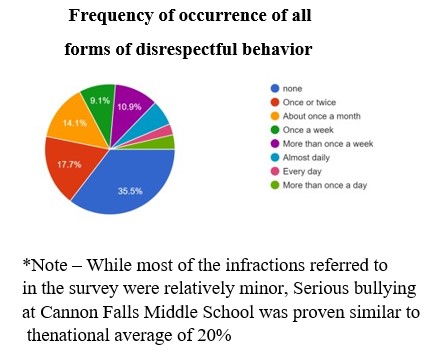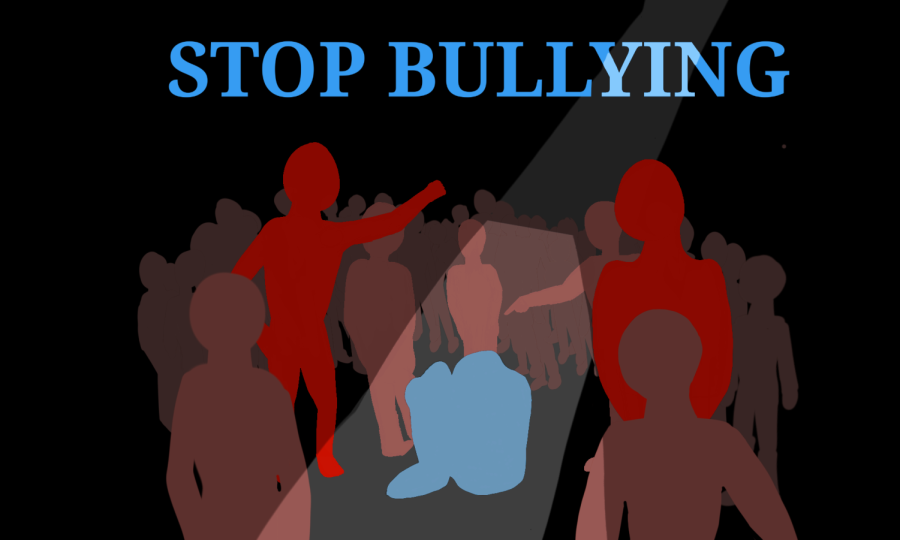What did I do?
The Torch staff has investigated the extent of hurtful treatment among middle school students at CFMS using a survey and interviews.
Bullying has been an issue in middle schools across the country for many years
Across the country, children and young adults are victims of bullying, whether they’re being called names for their height or weight, being shoved against a wall, or left thinking “What did I do?” Most of the time, people are bullied for conditions that can’t be changed or they are treated with disrespect for opinions and choices. Oppressors can cause victims to feel worse and worse about themselves, until eventually the stress of handling it can create suicidal thoughts. Bullying is extremely complex and should be looked at and handled carefully. Because of that, Cannon Falls MS conducted a survey to see how many students have experienced bullying.
Different people have different definitions of bullying. The Minnesota State Legislature describes bullying as threatening, intimidating, or harming someone in a way that is offensive. It can affect the way students think about themselves, and cause them to have low self-esteem. Bullying can also influence students’ academic, home, and social life.
Steven Strauss, the assistant principal at Cannon Falls Area Schools, usually deals with situations related to bullying. He was asked about what happens after an incident involving bullying occurs and how the school handles them. “When an issue comes to either myself or Mr. Hodges, we get all the details from the individual. Sometimes it’s from the victim, sometimes it’s from a witness, and we ask the individual if they want to fill out a bullying report,” he stated. “If they fill out a bullying report, then we specifically have to take action on it and interview everybody within 48 hours.”
Oftentimes, the word “bullying” is just thrown around as a general term, but it’s more than just that. Bullying should be broken up into smaller categories, because there are multiple pieces to it. First, there is teasing and mocking someone. While it is never okay to hurt somebody’s feelings in that way, it isn’t exactly bullying. Especially if it isn’t consistent, as in every day/week, it shouldn’t be considered as bullying. Then, there’s being threatened, harmed, or hazed. While hazing usually happens among older groups, like college and high school students, being threatened or harmed is something that happens with any age. If it happens more than once, it should be considered bullying.
Bullying affects students in an extreme way. While it may seem harmless to the ones who do it, it has a tremendous emotional impact on every single one of the victims. However, a lot of people don’t realize that the issue of bullying starts with the question of why bullies act the way they do. Kirsten Hoffman, a trusted guidance counselor at Cannon Falls MSHS, talked about some of the following as reasons that students might bully. A lot of them are bullies because they have low self esteem, and make fun of others because of their own insecurities. Others feel that it gives them a sense of power or makes them feel better about themselves. They also might act that way because of someone at home, and they’re just doing what the role model does.
There was a survey taken by the middle school students at Cannon Falls MS. Out of 267 students, 82% took the survey. Body shaming is a big problem, and students at Cannon Falls have definitely experienced it. Students were verbally harassed, made fun of because of religion, and harmed or teased because of their appearance. According to the analysis, at least 37 students have dealt with being treated with disrespect online. Only 9% of students have had to deal with bullying once a week, and 11% dealt with it more than once a week.

Bullying is an immense problem in today’s society, especially involving teenagers and young adults. However, there are still ways to fix it. If someone witnesses bullying, but stands by and watches, they still hold part of the blame. There are ways to help someone who’s bullied. Simply taking the victim somewhere they can feel safe is an easy solution to help out. For teenagers and kids, telling a trusted adult about the issue helps solve the problem too. Sometimes a victim needs someone to talk to, and anyone can be that person. No one should ever bully, but sometimes people don’t understand that while what they’re doing seems harmless, it is affecting someone greatly. Today’s society is constantly changing, as are the “standards” for what bullying would be, but people should always try their best to do the right thing.
*Note – This article is published by middle School students in the Torch, which is a portion of the Lantern

Hi everyone! I’m a sophomore and this year marks my fifth with the Lantern, and my second as an editor. I play volleyball and run track, and am also...

